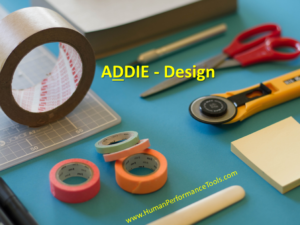The Design Phase of ADDIE: Part 3 of 6
 When creating highly effective training using the ADDIE process, what is the Design phase? Following a thorough Analysis, it is the process used to determine the learning outcomes and objectives of the training. Not only are the objectives determined, but proof of learning assessment tools are chosen here - a tribute to Stephen Covey's "Beginning with the end in mind" habit. There needs to be a reason why you do each part of the training, and those reasons are linked and decided on here - each content piece and exam question needs to be supportive of a learning objective, or it doesn't belong in the course. Information obtained from the analysis phase is used along with adult learning theories and principles of learning. The design stage determines the strategies used to create the course.
When creating highly effective training using the ADDIE process, what is the Design phase? Following a thorough Analysis, it is the process used to determine the learning outcomes and objectives of the training. Not only are the objectives determined, but proof of learning assessment tools are chosen here - a tribute to Stephen Covey's "Beginning with the end in mind" habit. There needs to be a reason why you do each part of the training, and those reasons are linked and decided on here - each content piece and exam question needs to be supportive of a learning objective, or it doesn't belong in the course. Information obtained from the analysis phase is used along with adult learning theories and principles of learning. The design stage determines the strategies used to create the course.
Author side note: There is no reason why this has to be over-complicated - not to say it's easy, but to say that the following three steps are an amalgamation of many different resources and my own input. I choose to keep it straightforward and as structured as possible. Stay within the ADDIE framework, and your product will benefit. The video link in the picture approaches this in a very slightly different but same way of analysis, which I feel is already done by this point, but I do love the video.
- Analysis
- Design
- Development
- Implementation
- Evaluation
Three Design Steps
Step 1: Clearly define all learning outcomes and hierarchical objectives by learning domain:
- Cognitive - Knowledge - Head
- Affective - Attitude - Heart
- Psychomotor - Skill - Hands
This is the most difficult and most important step. I've had to revise training that never identified Objectives, so my first step was to analyze the course and determine what the objectives should have been from the get-go. When you do this, you find all sorts of content that doesn't relate to the heart of the outcomes that will then need to be edited or removed.
Step 2: Make final determinations for:
- Where and how the course will be taught
- Which software/technology will be used to support the course (Power Point, Prezi, Keynote, Adobe Suite, Articulate Suite, etc)
- The overall structure, look, and feel/ template graphic design
- User-interface / Instructor led or e-Learning and what kind (Synchronous or Asynchronous)
- If e-Learning will it be text-driven, interactive, or simulation?
- Content sources and subject matter analysis
- Media selection (text, graphics, audio narration, video, photos, etc.)
- Exercises, applicable and appropriate games, and activities (collaborative, interactive or per participant for the participants to practice the new knowledge or learned skills and gauge their performance)
- Time frames for each instructional element
- Handouts and student materials necessary to support the course
- Assessment instruments (Quizzes, exams, methodology, etc.)
- Plan and necessary resources (for example, Subject Matter Experts)
- Who will the instructors will be and what skills will they need to teach the course?
- Who will the student population be and how can the training be designed to appeal to them?
- How can students give feedback on the course?
- Timeline for pilot prototype delivery
Step 3: Create storyboards
Here are some helpful resources you can use to create awesome storyboards (if you're going to get fancier than a white board or power point, which is what I typically use):
WikiHow: How to Create a Storyboard